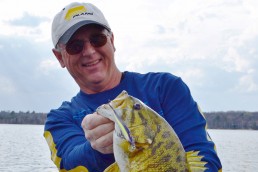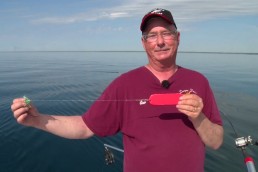Hang Time is the Key to Catching Sluggish Bass
SHARE THIS POST
When conditions are less than ideal, bass are apt to thumb their noses at most aggressive lure presentations. This is particularly true when there is a lot of fishing pressure, but also occurs when the water is ultra-clear. Casting suspender-style jerkbaits over promising spots and working them with a prolonged pause—or what a football punter would term “hang time”—is often the key to success. This tactic can produce in a variety of conditions, but it really excels when the bite is off.
Working minnow-style lures in this fashion is certainly nothing new. In fact, bass anglers have been working minnow baits in a jerkbait fashion for decades. Even before the tackle market started producing true suspender-style lures, savvy bassers were modifying floaters with lead tape, oversized hooks and even drilling holes in the lure bodies to decrease their buoyancy and promote the desired hang time over a likely bass haunt.
That lack of buoyancy is the key to success with this style of fishing. Ideally, you’re striving to find or create a lure that neither floats nor sinks. It’s a lofty goal to seek perfect neutral buoyancy since different water temperatures along with line test, composition and terminal hardware, all affect the hang time of any given lure. In fact, you may become frustrated occasionally by lures that either sink or float, but never truly suspend. Most of the factory-made suspender jerkbaits sold today rarely suspend perfectly; most of them sink slowly. You can offset and eliminate sinkage by simply changing the lure’s trebles to a lighter-gauge set. Switching to a floating line such as mono or braid over flourocarbon is bound to kill or slow down the sink rate on most lures.
The opposite trick is equally effective. If your suspending minnow bait floats, you can easily decrease or completely eliminate its buoyancy by replacing the stock trebles with a larger set. Then, snap or tie it onto a rod/reel combo loaded with a flourocarbon line, which has naturally has a sinking nature to it. That same lure will lose most of its float characteristics.
Most tackle shops today also stock stick-on lead tape, Suspend-A-Dot, for this application. By attaching a few dots or strips of lead tape to your lure in the center point area of its underbelly, a floater becomes a suspender or even a sinker in short order. Admittedly, I am addicted to this product Suspend-A-Dot and use it all the time to alter the weight and buoyancy of my favorite baits. It is a mainstay in my tackle box. By the way, many hardware chains also carry stick-on lead tape for various applications and it works well for fishing lure modifications.
Are you enjoying this post?
You can be among the first to get the latest info on where to go, what to use and how to use it!
Precisely where you attach stick-on tape on a lure greatly affects its performance, castability and action. Some jerkbait specialists like a lure that suspends perfectly level in the water while others prefer a nose-up or nose-down profile. Generally, what I like to do is find the balancing spot on any given lure by lightly pinching the sides between my forefinger and thumb. If the nose dips downward, I’ll move my pinch toward the nose, and vice versa. Once I find a balance spot I mark it and apply lead tape to that area initially to decrease buoyancy. Additionally, I’m apt to apply more tape in front or behind that spot to modify the lure’s action to suite my needs at any one moment.
The best way to work a suspender jerkbait is to vary a lot, according to conditions. For example, in the early season or late season with colder water temperatures of 52 degrees or less, usually this requires a slower overall retrieve combined with prolonged pauses. Conversely, warming water temperatures are almost sure to demand a faster pace. Typically, I like to mix it up inside any given retrieve no matter the conditions, but I nearly always allow extra hang time when the lure is near a promising spot such as a weed clump, brush pile, sunken log, large boulder or man-made fish crib. However, once the lure is away from cover, I speed up the cadence considerably. This allows me to cover far more water in a shorter time while allowing the lure to do its hang time at critical stages.
Size is often critical to success. Generally, I fish the 3 1/2- to 4-inch versions the most, but I don’t hesitate to move up to a larger size when the bass are running big. Perhaps the best time for a bigger bait is when casting over flats with larger schools of mixed-sized bass. The bigger profile seems to discourage more of the smaller to midsized fish while attracting aggressive responses from lunker-class bass. In fact, upsizing to jerkbaits over 5 inches is sometimes necessary to really cull out small fish in the large schools.
Finally, experiment with colors endlessly until you hit on a winner. Generally, I start out with bright-colored patterns and even chromes that I can see well. But sometimes gin-clear-water bass want a nearly translucent pattern. Keep testing the fish with various color patterns until you notice a better response to one over the other.
MWO
SHARE THIS POST
Did you enjoy this post?
You can be among the first to get the latest info on where to go, what to use and how to use it!
Joe Bucher
Joe Bucher is a Freshwater Fishing Hall of Fame Legendary Angler, book author, lure designer and host of Fishing with Joe Bucher TV series.



